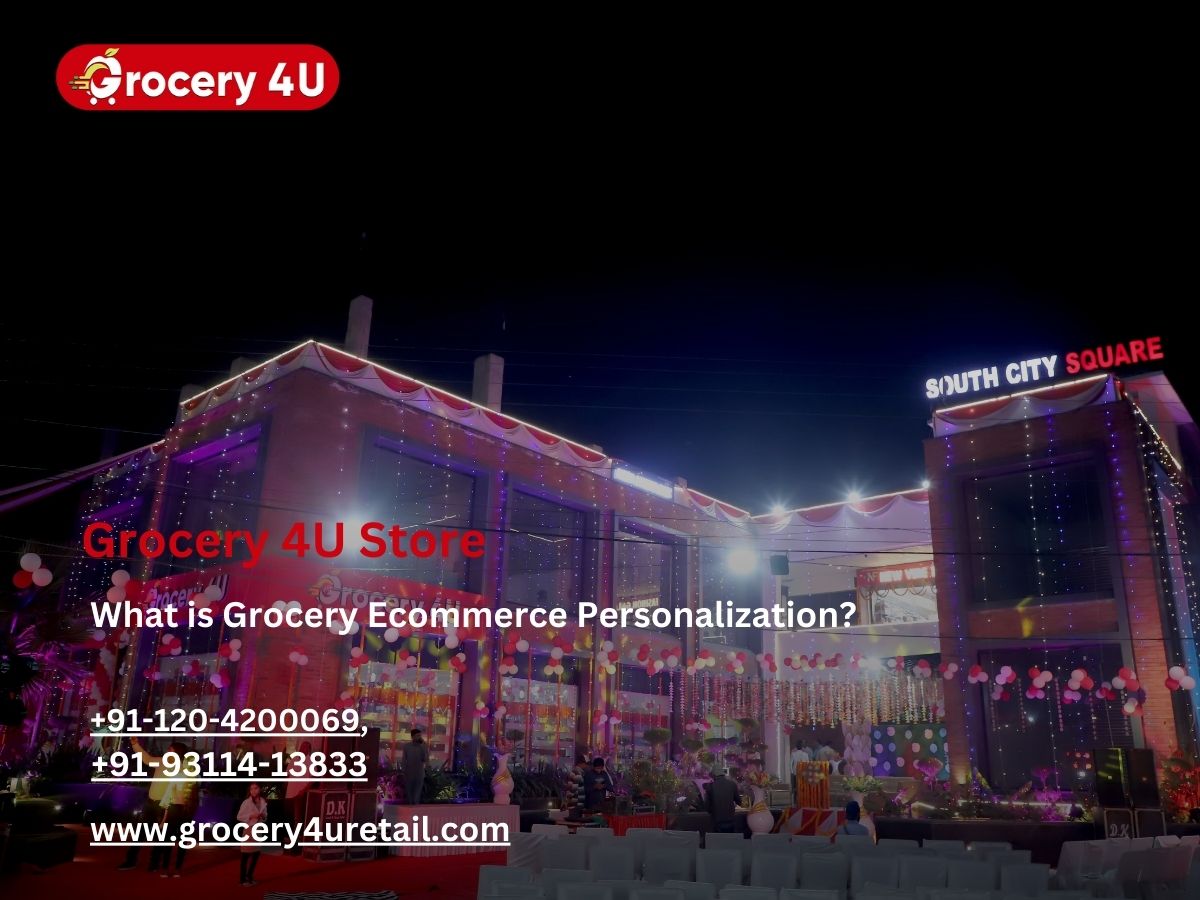E-commerce personalization refers to the strategic utilization of customer data, behaviors, and insights to craft a tailored shopping experience for individual users. This approach is especially vital in the e-grocery sector, where the extensive variety of available products means each customer’s journey can differ significantly. By leveraging various data points—including demographic information like age, gender, and location, as well as psychographic factors such as shopping habits and preferences—grocery brands can effectively meet the unique needs of each shopper.
The Importance of Personalization
In today’s digital marketplace, the ability to deliver personalized experiences is essential. Consumers increasingly seek brands that understand their preferences and behaviors. A remarkable 80% of consumers indicate a willingness to shop with brands that demonstrate a clear understanding of their individual needs. Personalization can manifest in various forms, from simple gestures, such as addressing a customer by name, to more complex offerings, like product recommendations based on a user’s browsing history.
In the grocery sector, personalization not only enhances the shopping experience but also extends to marketing strategies. Brands can analyze customer segments to determine the most effective ways to communicate, whether through tone of voice, preferred communication channels, or specific offers. This tailored approach leads to more effective engagement, fostering loyalty and improving overall customer satisfaction.
Despite concerns regarding privacy, consumers often prefer personalized shopping experiences. They appreciate brands that take the time to understand their preferences, leading to a more enjoyable and efficient shopping process. The challenge for grocery brands lies in balancing personalization with privacy, ensuring that customers feel valued without compromising their data security.
How Grocery Brands Utilize Personalization
Grocery brands can implement personalization in several impactful ways:
- Targeted Recommendations: By analyzing past purchases and browsing behavior, grocery platforms can suggest items that are likely to resonate with the customer, enhancing the likelihood of additional sales.
- Custom Offers: Brands can create tailored promotions and discounts that cater to specific consumer segments, increasing the relevance of marketing efforts.
- Enhanced Communication: Personalizing marketing communications ensures that messages are relevant and engaging for various customer groups, leading to better responses.
Over time, effective personalization strategies can increase average order values and foster brand loyalty, ultimately enhancing the overall customer experience.
Types of E-commerce Personalization in E-Grocery Stores
Given the extensive range of products offered by e-grocery retailers, there are multiple customer touchpoints that can be leveraged for personalization. Each interaction—whether browsing products, adding items to a cart, or completing a purchase—generates valuable data that can be harnessed to tailor the shopping experience effectively.
1. Manual Personalization by the Customer
One fundamental aspect of e-commerce personalization involves empowering customers to manually tailor their experience. E-grocery platforms often include features that allow users to customize their shopping environment. For instance:
- Favorites and Wish Lists: Customers can mark items as favorites or save them for future purchases, simplifying access to preferred products.
- Saved Addresses: Users can input and save multiple delivery addresses, streamlining the checkout process and enhancing convenience.
- Loyalty Programs: Customers can link their loyalty cards to ensure they receive relevant discounts and promotions, reinforcing brand loyalty.
This form of personalization significantly enhances the user experience by saving time and ensuring customers can easily locate the products they need. Moreover, the data collected through these manual actions can feed into advanced recommendation algorithms, further refining the personalization process.
2. Manual Personalization by the Partner
In addition to allowing customers to customize their experience, grocery brands can also personalize offerings through their marketing efforts. Platforms like Grocery4u enable partners to segment customers based on purchasing behavior and demographics. This segmentation allows for targeted marketing initiatives that cater specifically to the preferences of different user segments. For example:
- Tailored Discounts: Brands can offer exclusive promotions to certain groups, enhancing engagement and satisfaction.
- Personalized Notifications: Sending notifications about sales or new product launches can be customized to reflect the interests of specific customer segments.
With consumers increasingly expecting personalized interactions, this form of manual personalization can significantly elevate customer engagement and satisfaction, ultimately driving higher sales.
3. Automated Personalization
Automated personalization takes the process a step further by leveraging technology to create dynamic and personalized shopping experiences in real time. This can include:
- Smart Product Recommendations: When a customer adds an item to their cart, the system can automatically suggest complementary products based on common purchasing patterns, increasing cross-selling opportunities.
- Enhanced Search Functionality: Automated systems can improve search results by suggesting products that align with the user’s past purchases and preferences, often labeled as “For You” recommendations.
- Checkout Suggestions: Before finalizing their order, customers may receive suggestions for commonly forgotten items, encouraging them to add more products to their cart.
This form of personalization is crucial for driving sales and increasing average order values, particularly in the competitive e-grocery landscape.
How Does E-commerce Personalization Work?
As technology continues to evolve, the systems and methodologies underpinning e-commerce personalization are becoming increasingly sophisticated. Generally, three fundamental elements are involved in the personalization process:
1. Data Capturing
The first step involves capturing consumer insights from various interactions on the grocery website or app. This includes gathering data from customer profiles, tracking behavior on the platform, and collecting feedback through surveys and questionnaires. By obtaining a comprehensive understanding of customer behavior, grocery brands can tailor their offerings more effectively.
2. Data Storage and Formatting
Once data is captured, it is stored in secure data warehouses, often in the cloud. This storage system ensures that data is accessible across the organization while maintaining data integrity. Unstructured data, such as customer reviews or feedback, is transformed into structured formats, enabling more effective analysis and actionable insights.
3. Data Analysis and Insights
The final stage involves analyzing the stored data to generate actionable insights. Businesses can utilize advanced analytics tools to identify trends and patterns in consumer behavior, informing their personalization strategies. By examining these insights, brands can adapt their offerings to better suit customer needs, ultimately enhancing satisfaction and driving sales.
The Role of AI and Machine Learning
A notable trend in e-commerce personalization is the integration of artificial intelligence (AI) and machine learning (ML). These technologies significantly enhance the ability to analyze vast amounts of data quickly, enabling more precise customer insights. For instance, platforms like Grocery4u employ AI to sift through customer interactions, purchase history, and behavioral data to create highly accurate product recommendations.
By harnessing these advanced technologies, grocery brands can improve the efficiency of their personalization efforts, optimize their sales strategies, and enhance customer experiences. AI and ML allow brands to predict future purchasing behaviors, personalize communications, and recommend products in real time, all of which contribute to a more seamless shopping experience.
Benefits of E-commerce Personalization for Businesses
Personalization offers numerous advantages for grocery businesses, impacting both customer satisfaction and the bottom line. Key benefits include:
Increased Lifetime Value
When customers receive tailored recommendations, they are more likely to make repeat purchases. This consistent engagement throughout their shopping journey significantly enhances their lifetime value. For grocery brands, this translates into increased revenue as customers add more products to their carts over time.
Boosted Customer Loyalty
Building and maintaining customer loyalty is critical for any business. Research shows that 76% of customers who do not receive a personalized experience express frustration. By offering personalized interactions, businesses can enhance customer satisfaction and turn first-time shoppers into loyal patrons. Loyalty programs that reward personalized shopping behaviors can further solidify these relationships.
More Effective Marketing Materials
Personalized marketing has proven to be more effective than generic approaches. Over 60% of marketing teams report that personalized materials lead to higher conversion rates and increased engagement. By tailoring marketing campaigns to specific customer segments, grocery brands can effectively capture attention and drive sales, ultimately leading to a better return on investment (ROI).
Enhanced Customer Experience
The cumulative effect of personalization leads to an enhanced overall customer experience. When customers feel understood and valued, they are more likely to return to a brand. Positive experiences foster trust, encouraging customers to choose the same brand for future purchases.
Competitive Advantage
In the increasingly competitive e-grocery market, effective personalization strategies can set a brand apart from its competitors. By delivering exceptional and tailored shopping experiences, brands can establish themselves as leaders in the market, attracting new customers while retaining existing ones.
E-commerce personalization has become an essential component of the modern grocery shopping experience. By leveraging customer data and technology, grocery brands can create tailored shopping experiences that enhance customer satisfaction and loyalty. The ongoing evolution of AI and machine learning further amplifies these capabilities, allowing for more precise insights and recommendations.
As the grocery industry continues to embrace digital transformation, the importance of personalization will only grow. By investing in these strategies, grocery brands can improve their bottom line and cultivate lasting relationships with their customers. Ultimately, personalization is not just a trend; it is a critical business strategy that will shape the future of e-commerce in the grocery sector. By recognizing the value of personalized experiences, brands can thrive in an ever-changing landscape, ensuring they remain relevant and competitive in the digital marketplace.



